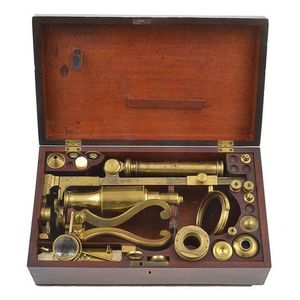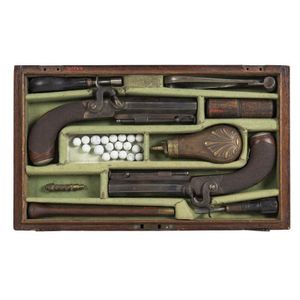William Parker Percussion Duelling Pistols & Case
You must be a subscriber, and be logged in to view price and dealer details.
Subscribe Now to view actual auction price for this item
When you subscribe, you have the option of setting the currency in which to display prices to $Au, $US, $NZ or Stg.
- Mahogany - Mahogany is a dense, close grained red-coloured timber from the West Indies and Central America. It was first imported into Europe in the the early 18th century and its use continued through the 19th century. It was popular for furniture making because of its strength, the wide boards available, the distinctive grain on some boards, termed flame mahogany and the rich warm colour of the timber when it was polished.. The "flame" was produced where a limb grew out from the trunk of the tree, and this timber was usually sliced into veneers for feature panels on doors, backs and cornices.
Some terms used to describe mahogany relate to the country from which it originally came, such as "Cuban" mahogany, "Honduras" mahogany etc. However unless the wood has been tested the names assigned are more a selling feature, rather than a true indication of the timber's origin. - Baize - Baize is a type of fabric that is made from wool or a wool blend. It is a dense, closely-woven fabric that is smooth to the touch and has a matte finish. Baize is often used for covering surfaces, such as table tops or the playing surface of card, pool and billiard tables, and for lining drawers and boxes, because it is durable and resistant to wear. This fabric is often associated with gambling and is often used on casino gaming tables and other gaming equipment.
- Circa - A Latin term meaning 'about', often used in the antique trade to give an approximate date for the piece, usually considered to be five years on either side of the circa year. Thus, circa 1900 means the piece was made about 1900, probably between 1895 and 1905. The expression is sometimes abbreviated to c.1900.
This item has been included into following indexes:
- firearms, pistols
Visually similar items

A rare 18th century cased compound and simple microscope, George Adams (c. 1709-1773), London, eight objectives for compound and four simple lenses, together with accessories including ivory slides, cased in mahogany box, 36 x 21.5 x 12.5 cm. Catalogue not

A 'Grand European' Winchester 12 gauge double barrel under and over shotgun, checkered flame mahogany fore-end and stock, finely engraved lock and fittings, all-over floral and scroll detail, in very good overall condition, in original dark red/brown leath

Very nice pair of single shot percussion turn-off barrel pistols with rifled Damascus barrels. Ebonised grips, in a later case, 19th century. (No Licence Required)

A pair of percussion cap pistols by S. King of London, circa 1850s, in original fitted case (missing lid) with accessories including nipple wrench, bullet mould, powder flask, balls etc. Ex museum display item hence the missing lid
